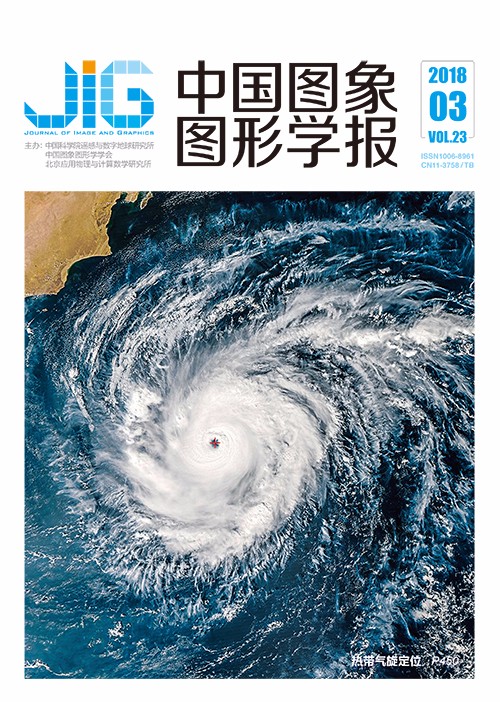
热带气旋客观定位的红外亮温方差方法
张长江1, 薛利成1, 马雷鸣2,3, 鲁小琴4(1.浙江师范大学数理与信息工程学院, 金华 321004;2.上海中心气象台, 上海 200030;3.上海市气象与健康重点实验室, 上海 200030;4.中国气象局上海台风研究所, 上海 200030) 摘 要
目的 热带气旋(TC)是生成于热带或副热带洋面上的强烈天气系统。在TC的监测分析和预报工作中,准确地确定其中心实时地理位置至关重要。此外,TC的精确位置也是TC强度估计的重要参数。对此,提出一种利用偏差角方差定位TC中心的方法。方法 首先,从红外卫星云图中截取热带气旋主体云系区域,并分别利用Bezier直方图和K均值聚类方法分割得到主体云系二值图像和红外亮温变化剧烈位置二值图像。其中,主体云系二值图像可将TC的主体云系从卫星红外云图中分割提取出来,用割提取出来的图像进行定位可以剔除掉外散环流的小云块对定位结果的影响;而红外亮温变化剧烈位置二值图像则可分别将TC中心密闭云区,螺旋云带和外散环流的边缘及梯度较大区域分割出来,这些区域是最后TC中心定位的主要依据。将上述两幅二值图像相与得到气旋主体云系红外亮温变化剧烈位置的二值图像,这一步剔除了TC的外散环流,而得到的二值图像便可分别将TC中心密闭云区和螺旋云带的边缘及梯度较大的区域分割出来。然后,对得到的气旋主体云系红外亮温变化剧烈位置二值图像进行Hough变换检测以减小气旋中心的搜索范围。最后,以检测区域内每个像素点为参考中心计算得到偏差角矩阵,并计算偏差角矩阵的方差填入对应检测区域内作为参考中心像素点的位置得到方差矩阵,将方差矩阵中值最小的位置作为气旋中心。因为TC除了少数特别强的时候大多数可以用圆形描述,而绝大多数时候TC要用螺旋线描述,但是具体是几度螺旋线来描述合适很难确定,本文用偏差角的方差就可以衡量这些云带、边缘的偏离状况是否集中,方差越小就表示偏离状况越集中。结果 运用该方法对400幅无眼TC红外图像和197幅有眼TC红外图像进行中心定位,分别与中国气象局(CMA)、日本气象厅(JMA)和美国台风预警中心(JTWC)的主观定位结果进行比较并取平均偏差,本文方法对有眼TC定位平均偏差约为27 km,无眼TC平均偏差约为45 km。具体到分别与CMA、JMA和JTWC的比较,对于有眼TC定位偏差分别为26.82 km,26.05 km和27.84 km,无眼TC定位偏差为45.84 km,44.84 km和47.15 km。结论 就结果而言,本文方法定位与CMA、JMA的偏差比较接近,与JTWC的偏差较大。就西北太平洋的TC而言,CMA和JMA的定位精度较高,JTWC精度稍低,这是与认知相符合,并且也证明了本文方法具有较高的可信度。此外,本文方法为TC定位提供了新的参考依据。
关键词
Infrared brightness-temperature variance method for the objective location of tropical cyclones
Zhang Changjiang1, Xue Licheng1, Ma Leiming2,3, Lu Xiaoqin4(1.College of Mathematics, Physics and Information Engineering, Zhejiang Normal University, Jinhua 321004, China;2.Shanghai Central Meteorological Observatory, Shanghai 200030, China;3.Shanghai Key Laboratory of Meteorology and Health, Shanghai 200030, China;4.Shanghai Typhoon Institute of China Meteorological Administration, Shanghai 200030, China) Abstract
Objective A tropical cyclone (TC) is a strong weather system generated in tropical or subtropical surfaces. In the analysis and forecasting of TC, accurately determining the real-time location of its center accurately is important. The precise location of TC is an important parameter of TC strength estimation. This paper presents a new method for locating the center of TC with deviation angle variance. Method First, an area of interest is selected from an infrared satellite cloud image. On the basis of this image, the Bezier histogram segmentation method is employed to obtain the binary image of the TC core region. The core region of the TC can be extracted from the satellite infrared cloud image by the binary image of the TC core region. The influence of the small cloud block on the locating result can be removed using the extracted image. K-means clustering segmentation is used to deal with the cloud region with violent changes in infrared bright temperature. The TC edge region and the large gradient region of the TC core region, the spiral cloud band, and the discrete cloud blocks that form a circular flow can be extracted from the satellite infrared cloud image by using the binary image of the cloud region, in which infrared bright temperature changes violently. These regions are the main basis for the positioning of the TC center. The two binary images are combined to obtain a new binary image. The discrete cloud blocks were removed from the TC. The TC edge region and the large gradient region of the TC core region and spiral cloud band can be extracted from the satellite infrared cloud image using the new binary image. The resulting binary image is detected by the Hough transform approach to reduce the search range of the center position of the TC. Finally, the deviation angle matrix is calculated from each pixel in the detection area as the reference center. The variance matrix is obtained by calculating the variance of the deviation angle matrix and filling it in the corresponding reference center pixel point of the detection area. The minimum value position of the variance matrix is taken as the corresponding TC center position. The TC can be described in circles except in a few special cases. The TC is described as spiral most of the time. However, exact identification of the appropriate number degrees of the spiral. The variance of the deviation angle matrix can be used to measure whether these cloud bands and edges are concentrated or not. A small variance corresponds to a concentrated deviation, that is, a small variance corresponds to a high concentration of bias of the TC toward a definite spiral angle. Result In contrast to the center position issued by China Meteorological Administration (CMA), the Japan Meteorological Agency (JMA), and the US Typhoon Warning Center (JTWC), the average location deviation of the eyed (no-eye) TC determined by the new method is approximately 27 km (45 km). Specific to CMA, JMA, and JTWC, the location deviation of the eyed (no-eye) TC determined by the new method is 26.82 (45.84), 26.05 (44.84), and 27.84 km (47.15 km), respectively. Conclusion The location deviation of JTWC is greater than that of CMA and JMA. In the case of TCs in the northwest Pacific, the positioning accuracy of CMA and JMA is slightly higher than that of JTWC, which is consistent with cognition. This finding proves that this method has high credibility. In this regard, the new method should be valuable for future operational TC center positioning.
Keywords
|



 中国图象图形学报 │ 京ICP备05080539号-4 │ 本系统由
中国图象图形学报 │ 京ICP备05080539号-4 │ 本系统由